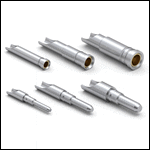The Impact of Electric and Hybrid Vehicles on Powertrain Connectors
For the new electric and hybrid vehicles, powertrain controls and connectors require the complete functionality of a conventional vehicle, plus the components required to drive the electric motor and charge the Lithium-ion battery pack.
Worldwide production of electric vehicles (EV) and hybrid electric vehicles (HEV) reached two million units in 2014, nearly doubling since 2011 and representing about 2% of total car and light truck production. Based on published data from multiple sources, this number is expected to reach five million units by 2020, or nearly 5% of total light vehicle production.
Here, we will look at the electric vehicle sector, which includes battery-powered electrical vehicles and extended-range electric vehicles, and the hybrid vehicle sector, which includes classic hybrid vehicles, pluggable hybrid electric vehicles, and mild hybrid electric vehicles. Over the forecast timeframe, HEV powertrains represent the largest share of the applications, accounting for 95% of the 2014 production and 90% in 2020.

Figure 1: 2012 Infiniti M-35 hybrid powertrain
Figure 1 illustrates the key components of a typical hybrid electric vehicle powertrain. The powertrain controls and connectors require the complete functionality of a conventional vehicle, plus the components required to drive the electric motor and charge the Lithium-ion battery pack. The hybrid electric motor typically runs on 275-325 volts, requiring specialty high-voltage connectors and control systems. Figure 2 illustrates a typical high-voltage connector used in hybrid applications manufactured by Yazaki Corporation.

Figure 2: Yazaki high-voltage vehicle connector
These connectors are shielded and rated to carry up to 1,000 volts, depending on the design and connector manufacturer. Due to the special nature of the design and the relatively low production volumes, the connectors, along with the additional control modules, can increase the value of powertrain connectors from $32 per vehicle for a conventional powertrain to $75 for an HEV.

Figure 3: 2012 Ford Focus electric powertrain
Figure 3 illustrates a typical battery-powered electric vehicle. This photo clearly illustrates the high-voltage power distribution running between the battery pack and the electric motor. Compared to that in the hybrid electrical vehicle, the powertrain is somewhat simplified, eliminating control and connection functions specific to the internal combustion engine. This results in about a 20% reduction in the number of powertrain connections. As with the hybrid powertrain, however, volumes are quite low. We estimate the overall powertrain connector content in full electric vehicles is similar to hybrid vehicles, around $75 per vehicle.
To put all of this in perspective, the average vehicle, on a worldwide basis, contains $32 worth of powertrain connectors. This figure varies widely based on the region of the world, engine size, and transmission complexity. The table below summarizes the per-vehicle powertrain connector content by region of the world and the estimated electric vehicle and hybrid vehicle connector content.
Per-Vehicle Powertrain Connector Content
by Powertrain Type and Region of the World

Combining the above data with global vehicle production forecasts, Bishop & Associates forecasts the market for powertrain connectors in EV and HEV will grow from $151.6 million worldwide in 2014 to $450.6 million in 2020. This forecast assumes prices remain at current levels.
This article was contributed by Dennis Smith of Bishop & Associates.





